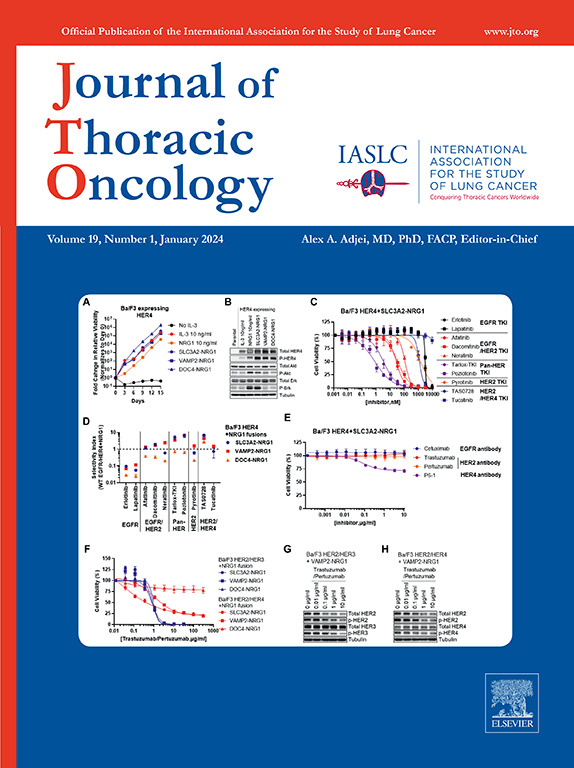First-Line Lorlatinib Versus Crizotinib in Asian Patients With Advanced ALK-Positive NSCLC: Five-Year Outcomes From the CROWN Study
IF 20.8
1区 医学
Q1 ONCOLOGY
引用次数: 0
Abstract
Introduction
Lorlatinib, a third-generation anaplastic lymphoma kinase inhibitor, reported significantly longer progression-free survival (PFS) than crizotinib in the phase 3 CROWN trial (NCT03052608) in patients with previously untreated advanced anaplastic lymphoma kinase–positive NSCLC. Efficacy was similar in the Asian subgroup. We present an updated subgroup analysis in Asian patients after five years of follow-up.
Methods
Patients were randomly (1:1) assigned to receive lorlatinib 100 mg once daily (n = 59) or crizotinib 250 mg twice daily (n = 61). This post hoc analysis presents updated investigator-assessed efficacy outcomes, safety, and biomarker analyses.
Results
After a median follow-up of 62.4 months for lorlatinib and 55.1 months for crizotinib, median PFS was not reached (NR, 95% confidence interval [CI]: 64.3‒NR) and 9.2 months (95% CI: 7.2‒12.7), respectively (hazard ratio [HR] = 0.22, 95% CI: 0.13‒0.37); the five-year PFS was 63% (95% CI: 49–74) and 7% (95% CI: 2–17). The objective response rate was 81% (95% CI: 69–90) with lorlatinib and 59% (95% CI: 46‒71) with crizotinib. In patients with baseline brain metastases, the intracranial objective response rate was 69% (95% CI: 39‒91) with lorlatinib and 6% (95% CI: <1‒30) with crizotinib. The median time to intracranial progression was NR (95% CI: NR‒NR) and 14.6 months (95% CI: 9.2‒27.4), respectively (HR = 0.01, 95% CI: <0.01‒0.11). Safety profiles were consistent with the entire population.
Conclusions
After five years of follow-up, lorlatinib efficacy and safety in the Asian subgroup of CROWN continue to be consistent with those in the overall population, with PFS remaining unreached with lorlatinib.
Trial Registration
ClinicalTrials.gov identifier: NCT03052608

亚洲晚期alk阳性NSCLC患者的一线氯拉替尼与克唑替尼:来自CROWN研究的5年结果
Lorlatinib是第三代间变性淋巴瘤激酶(ALK)抑制剂,在先前未经治疗的晚期ALK阳性非小细胞肺癌(NSCLC)患者的3期CROWN试验(NCT03052608)中,Lorlatinib显示出比crizotinib更长的无进展生存期(PFS)。亚洲亚组的疗效相似。我们在5年的随访后对亚洲患者进行了最新的亚组分析。方法:患者随机(1:1)分配接受lorlatinib 100mg每日1次(n=59)或crizotinib 250mg每日2次(n=61)。这项事后分析提出了最新的研究者评估的疗效结果、安全性和生物标志物分析。结果:氯拉替尼和克唑替尼的中位随访时间分别为62.4个月和55.1个月,中位PFS未达到(NR;95%可信区间[CI]: 64.3-NR)和9.2个月(95% CI: 7.2-12.7)(风险比[HR]: 0.22;95% ci: 0.13-0.37);5年PFS分别为63% (95% CI: 49-74)和7% (95% CI: 2-17)。氯拉替尼的客观缓解率(ORR)为81% (95% CI: 69-90),克唑替尼为59% (95% CI: 46-71)。在基线脑转移患者中,氯拉替尼的颅内(IC) ORR为69% (95% CI: 39-91)和6% (95% CI:结论:经过5年的随访,氯拉替尼在亚洲亚组的疗效和安全性继续与总体人群一致,氯拉替尼的PFS仍未达到。
本文章由计算机程序翻译,如有差异,请以英文原文为准。
求助全文
约1分钟内获得全文
求助全文
来源期刊

Journal of Thoracic Oncology
医学-呼吸系统
CiteScore
36.00
自引率
3.90%
发文量
1406
审稿时长
13 days
期刊介绍:
Journal of Thoracic Oncology (JTO), the official journal of the International Association for the Study of Lung Cancer,is the primary educational and informational publication for topics relevant to the prevention, detection, diagnosis, and treatment of all thoracic malignancies.The readship includes epidemiologists, medical oncologists, radiation oncologists, thoracic surgeons, pulmonologists, radiologists, pathologists, nuclear medicine physicians, and research scientists with a special interest in thoracic oncology.
 求助内容:
求助内容: 应助结果提醒方式:
应助结果提醒方式:


